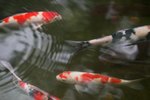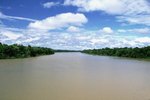
Sump filters are considered critical for reef aquariums but not so critical for freshwater aquariums -- though there's no reason they wouldn't work in freshwater. Many hobbyists make their own sump filters to save money and customize them. Homemade sump filters have considerable variation thanks to their DIY nature, but their assembly generally is fundamentally the same.
Planning Your Sump
Sump filters are extremely customizable. Carefully research and plan your sump before building it. Make sure you include baffles to corral bubbles and have room for equipment like protein skimmers and heaters. Despite the wide variety of designs, a few guidelines hold true. If you plan on having an in-sump refugium, set aside 10 percent of the volume of the sump for it. Additionally, the return pump for the sump should be able to move three to five times the display aquarium's volume per hour into the aquarium. Counterintuitively, smaller sumps should have sumps more toward the 5-gallons-per-hour end of this range, while larger sumps lean towards the smaller end of the range.
Assembling the Sump
Once you have your sump planned out, move on to assembly. Most of the assembly will consist of gluing panes into place to form baffles and the sides of the refugium. Keep in mind that if you use a glass sump, you should use glass baffles; if you use an acrylic sump, you should use acrylic baffles, since acrylic bonding agents tend to work poorly on glass and vice versa. If you need to drill any of the glass panes for baffles, do so before gluing them in place, since it is much easier to drill unattached panes. Make sure you give any bonding agent enough time to fully dry and cure; even aquarium-safe bonding agents may release toxic chemicals when curing.
Equipment Setup
The main piece of equipment a sump needs to function is a return pump. Installation consists of hooking it into the return plumbing, which can vary based on the your specific design of your tank accessories and your sump. Sumps often include equipment such as heaters, protein skimmers and automated top-off systems. Always install equipment per manufacturers' instructions. Never submerge equipment designed to operate outside the water, and never turn on submersible equipment when it's not submerged. Pumps may break and heaters may crack if operated incorrectly.
Final Assembly
Before starting the sump, fill it with aquarium water and make any final connections in the plumbing. Before your turn on the pumps, mark the water level on the outside of the sump with a permanent marker and label it "fill line." Once you activate the return pump, wait until water begins to flow back into the sump. Once water begins making a complete circuit, mark the new, lower water level and mark it "running line." Never fill the sump beyond this line when the pump is running. Otherwise, the sump could overflow if the pump fails.
References
Photo Credits
-
Ablestock.com/AbleStock.com/Getty Images




